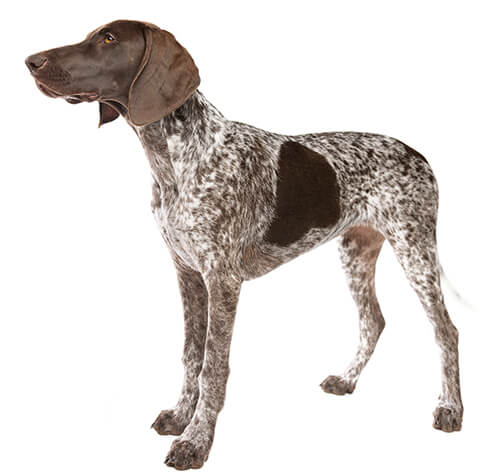
Highly intelligent and willing to please, the German Shorthaired Pointer is a multipurpose hunting dog with a powerful sense of smell and keen enthusiasm for work. A true athlete, the breed thrives with active families who give him regular exercise. A loyal companion and watchdog, the German Shorthaired Pointer has an even and friendly temperament. His coat sheds but requires little grooming.
DID YOU KNOW? The German Shorthaired Pointer has webbed feet, which help him to excel at swimming.
ALSO KNOWN AS: Deutscher kurzhaariger Vorstehhund, Deutsch Kurzhaar, Kurzhaar
The need-to-know
- Dog suitable for owners with some experience
- Some training required
- Enjoys vigorous walks
- Enjoys walking more than two hours a day
- Large dog
- Some drool
- Requires grooming once a week
- Non hypoallergenic breed
- Quiet dog
- Not a guard dog
- May require training to live with other pets
- Great family dog
Personality

The German Shorthaired Pointer is a gentle, loving, people-oriented dog who makes a good companion for an active family or individual who can give them the exercise, training and attention they need. They are highly attached to their owners and do not like to be left alone. They may not be reliable with small fluffy animals or unfamiliar cats although can learn to get on with their own.
History and Origins

Country of Origin: Germany
The German Shorthaired Pointer was created in Germany in the 17th century by crossing the Spanish Pointer with some of the early German bird dog breeds and, some historians suggest, Bloodhound. This was successful, but the new breed was heavy and slow and so in the 19th century steps were taken to improve the breed by crossing them with the English Pointer which produced a lighter, faster dog.
However, the emphasis has always been on the breed’s searching ability rather than their speed. The GSP is one of the versatile Hunt, Point and Retrieve (HPR) breeds and is happy to work on land and water. To their supporters, the German Shorthaired Pointer is the perfect, all-round gundog.
Nutrition and Feeding

Large breed dogs, as well as having large appetites, benefit from a different balance of nutrients including minerals and vitamins compared to smaller-breed dogs. German Shorthaired Pointers need a balanced diet that includes the main nutrients groups and a constant supply of fresh water.
Exercise

The German Shorthaired Pointer is very active and needs at least two hours of daily dog exercise. In addition to this they need plenty of enrichment, brain-games, training and stimulation to prevent them getting bored and making up their own entertainment - which can include digging, chewing, hyper-activity and generally getting up to mischief!
Other Information

Health and Common Concerns
The short-haired German Pointer is generally a healthy breed. However, as with many breeds, they can suffer from various hereditary eye disorders and hip dysplasia (a condition that can lead to mobility problems). Eye testing and hip scoring of dogs prior to breeding is therefore important. Epilepsy is also seen more commonly in this breed.
Space Requirements
This is a large country dog who needs space both indoors and out - and plenty of open countryside for exercise.
Training German Shorthaired Pointer
The German Shorthaired Pointer is an intelligent, clever dog who loves working with their owners and so can be trained to a high standard. They will excel with owners who can find pet gun dog classes where they can be taught to give these active working dogs an appropriate outlet for their natural hardwired hunting behaviours.
Best Family Dog Breeds
Being affectionate and friendly the German Shorthaired Pointer makes are great dog for active, sporty families. Their activity levels and playfulness may make them too boisterous around small children. While many dogs are traditionally thought of as being good with children, all dogs and children need to be taught to get on with each other and be safe together. Even so, dogs and young children should never be left alone together and adults should supervise all interactions between them.
Did You Know?
- The German Shorthaired Pointer was originally known as the Deutscher Kurzhariger Vorstehhund.